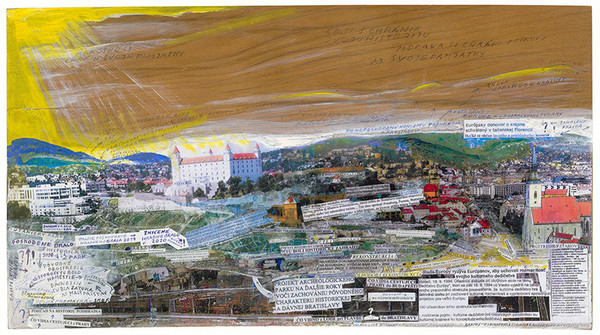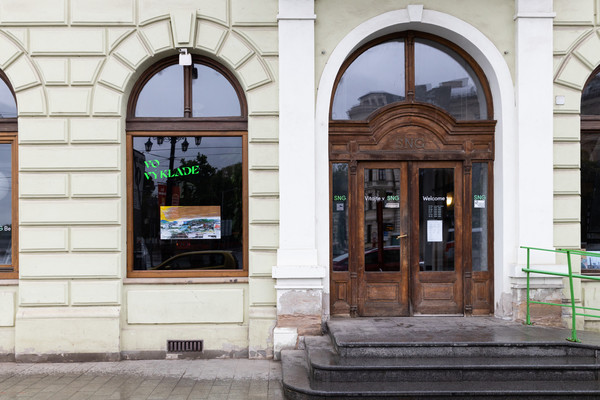The new exhibition cycle of the Slovak National Gallery, In the Shop Display, enters the public space through the window of Café Berlinka on the ground floor of the Esterházy Palace, presenting works of visual art responding to the issues of contemporary life. This new exhibition format has revived a collaboration between Peter Bartoš and Július Koller called Shop Display (Anti-Gallery).
In 1968, they exhibited their works in a storefront of a stocking repair shop in Klobučnícka Street in Bratislava. Symbolically, we commence the cycle with the work of Peter Bartoš (1938) titled The Drama of Bratislava Podhradie (2020). For many years, Bartoš has been dealing with the devastation of a rare historical, urban and natural area located below the Bratislava castle and within our immediate vicinity - an area currently undergoing radical changes. He brings an "apolitical" and "timeless" reflection on the concept of transformation of the historical Podhradie district, speculating about what could have been if we had only "listened" to this unique space and respected its character. Bartoš created a layered socio-cultural probe into the transformation of this space - a visual problem map - with proposals and ideas which he persistently distributes to the world around him.
The view of Bratislava Castle and Castle Hill is intimately known to the city residents and visitors alike. For a very long time, the view has been a source of pain, recently exacerbated by the sight of heavy machinery biting off large chunks of rock in pursuit of radical reconstruction and transformation. Peter Bartoš, one of the key figures of Slovak neo-avantgarde's key figures became the first visual artist since the 1960s to address - as he calls it - "relationships in nature" and later issues of ecology, the devastation of natural and cultural monuments and the environment in which we live. Bartoš has been dealing with the concept of transformation of the historical Podhradie district for a long time, and this work forms an integral part of his current oeuvre. He first encountered the Castle Hill problem through his son Ilja - as a student in the 1970s, he photographed the demolition of the Vydrica neighbourhood - part of the historic district of Zuckermandel. He included this "topic" in his (unofficial) exhibition Bleskovky a plagiáty (lit. Flash News and Plagiarism) presented at the Club of Visual Artists and Architects in 1978. Through his presentation, he commented on and criticised the numerous architectural interventions happening across Bratislava.
Peter Bartoš overlaps the pictorial motif - the photographic panorama of Bratislava Castle with the castle grounds - with a collage of texts, newspaper headlines, article clippings, own written comments, proposals and various painting interventions. Bartoš creates a "liquid" concept and "post-concept" of thinking about the changing historical identity of the area - the starting point of Lesser Carpathians and location of rare and invaluable natural habitats and archaeological excavation sites (both Celtic and Slavic in origin, Water Tower from the 13th century). Since the 1950s, architect and pedagogue Alfred Piffl asked his students to draw the historical form of the castle, supposedly for the future. However, the priorities at that time were elsewhere. Piffl used to say that: "Functionalism prevails over monuments even where an acceptable compromise can be found." Let us add to that, thanks to immortal developers; functionalism has won.
A key aspect of Bartoš's work focused on active and practical ecological landscaping. In numerous projects dealing with the Bratislava Podhradie, he used his previous experience designing an ecological Forest-Meadow Park above Lamač (concept 1972, project 1973, realisation and planting 1979). He is also known as a designer and composer of individual parts of the Bratislava Zoo, where he was employed (inner-city ZOO landscape, hills for breeding of Hucul horses, among others). Ľudmila Rampáková (1945), a former television author and dramaturge, intensively collaborated on Bartoš's vision for Bratislava Podhradie. She helped drawing attention to the archaeological sites (a project of archeo-park), rescued the southernmost edge of Castle Hill cliffs with the mahabel cherry tree and incorporated them into the existing environment. She also collaborated with Viliam Figusch from the office of the Council of Europe, which nominated her for the international exhibition Eco-Photography 2007, where she also presented her defence of the Bratislava Podhradie.
In the case of the Bratislava Podhradie, Peter Bartoš wishes to find an acceptable and sustainable compromise, one that he has been trying to offer to the competent at the Bratislava City Hall for the past twenty years. Trying to preserve the overall genius loci of the area, he designed various geo-ecological, landscaping and park interventions for Castle Hill and the area below him. Stubbornly defending his idea, he perceives this area as a valuable part of the common European cultural heritage. He has always seen things in the context of their relationships, which he tried to visualise, draw and describe in his paintings-projects. The initial flurry of information turns into an original visual system, a pictorial "hypertext", where everything connects to everything - a system one can not only read but one can also look at. We can also think of this work as an attempt at the symbolic and spiritual salvation of Bratislava. After all, the light from the left floods the whole panorama, sun's rays penetrating the darkness that hangs over us... In the author's understanding, it is the "divine light", a symbol of an all-encompassing and timeless good. Will it save us...?

